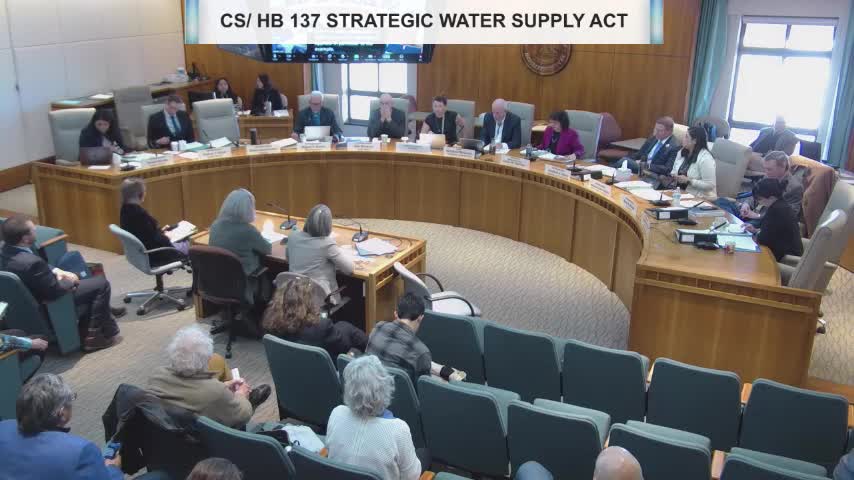Representative Garcia promotes brackish water use for hydrogen infrastructure initiatives
February 22, 2025 | Energy, Environment & Natural Resources, House of Representatives, Committees, Legislative, New Mexico
This article was created by AI summarizing key points discussed. AI makes mistakes, so for full details and context, please refer to the video of the full meeting. Please report any errors so we can fix them. Report an error »

In a pivotal meeting held on February 22, 2025, the New Mexico Legislature's House Committee on Energy, Environment, and Natural Resources delved into innovative approaches to water use and energy production, particularly focusing on the potential of brackish water in hydrogen fuel development. The discussion was sparked by Representative Garcia, who shared his enthusiasm for hydrogen fuel cells, recalling his involvement in early projects that demonstrated the technology's viability.
Garcia painted a vivid picture of a small-scale hydrogen production setup, likening it to a shoebox experiment that successfully powered a light bulb. This anecdote served as a metaphor for the potential breakthroughs that could arise from utilizing brackish water—a resource often overlooked in discussions about sustainable energy. He emphasized the need for alternative water sources to alleviate the pressure on fresh water supplies, especially in the context of hydrogen production.
Rebecca Ruse, an expert in the field, echoed Garcia's sentiments, highlighting the strategic water supply initiative aimed at creating alternative water sources for clean energy production. She pointed out that green hydrogen production requires significant amounts of water, ranging from 100,000 to 700,000 gallons per day, depending on the facility's scale. Ruse explained that House Bill 137 would facilitate funding and contracts for treating brackish water to meet the specific needs of hydrogen production facilities, thereby ensuring that drinking water supplies remain untouched.
However, the conversation was not without its skeptics. Some committee members raised concerns about the limitations of this approach. One representative cautioned that while treating brackish water could provide a solution for certain communities facing acute shortages, it would not address broader issues such as climate change or water scarcity. The representative stressed that this technology should not be seen as a panacea but rather as a potential tool for specific situations.
As the meeting concluded, it was clear that the discussions surrounding brackish water and hydrogen production are part of a larger narrative about New Mexico's energy future. The committee's exploration of these topics reflects a growing recognition of the need for innovative solutions to meet the state's energy demands while safeguarding its precious water resources. The implications of these discussions could shape the landscape of clean energy in New Mexico for years to come, leaving many eager to see how these ideas will evolve into actionable policies.
Garcia painted a vivid picture of a small-scale hydrogen production setup, likening it to a shoebox experiment that successfully powered a light bulb. This anecdote served as a metaphor for the potential breakthroughs that could arise from utilizing brackish water—a resource often overlooked in discussions about sustainable energy. He emphasized the need for alternative water sources to alleviate the pressure on fresh water supplies, especially in the context of hydrogen production.
Rebecca Ruse, an expert in the field, echoed Garcia's sentiments, highlighting the strategic water supply initiative aimed at creating alternative water sources for clean energy production. She pointed out that green hydrogen production requires significant amounts of water, ranging from 100,000 to 700,000 gallons per day, depending on the facility's scale. Ruse explained that House Bill 137 would facilitate funding and contracts for treating brackish water to meet the specific needs of hydrogen production facilities, thereby ensuring that drinking water supplies remain untouched.
However, the conversation was not without its skeptics. Some committee members raised concerns about the limitations of this approach. One representative cautioned that while treating brackish water could provide a solution for certain communities facing acute shortages, it would not address broader issues such as climate change or water scarcity. The representative stressed that this technology should not be seen as a panacea but rather as a potential tool for specific situations.
As the meeting concluded, it was clear that the discussions surrounding brackish water and hydrogen production are part of a larger narrative about New Mexico's energy future. The committee's exploration of these topics reflects a growing recognition of the need for innovative solutions to meet the state's energy demands while safeguarding its precious water resources. The implications of these discussions could shape the landscape of clean energy in New Mexico for years to come, leaving many eager to see how these ideas will evolve into actionable policies.
View full meeting
This article is based on a recent meeting—watch the full video and explore the complete transcript for deeper insights into the discussion.
View full meeting
